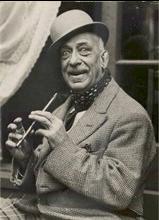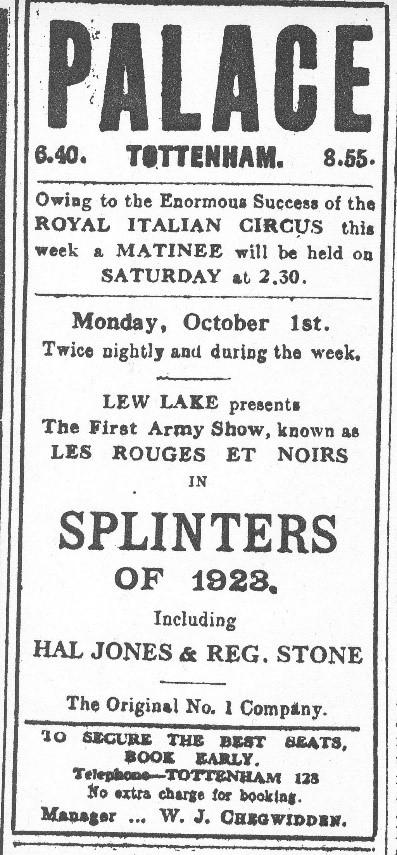The Tottenham Palace was built originally as the Tottenham Palace of Varieties in 1908, a theatre and music hall (you can see its date-stone high up on the side of the building). Facing stiff competition from the number of cinemas that had opened after the First World War, the Palace began to show films from 1922. from 1922 The Palace began to show films alongside its variety acts, before turning full time as a cinema.

(Tottenham Palace, 1908. From the collections and © Bruce Castle Museum and Archive)
One local recalls during the 1920s before the arrival of the ‘talkies’:
“We used to go up to ‘the gods’ in the Palace. We used to go see Charlie Chaplin for 6d. All the old films, the silent films. And all of a sudden, the platform would open and the organ would come up from underneath the floor.”
From its years of variety performances, two nationally-known acts of the Edwardian age appeared often at the Palace. Both were celebrities of the music hall stage: Harry Champion (1865 – 1942) - real name William Crump - who sang the popular songs "Any Old Iron", "I'm Henery the Eighth I am" and "Boiled Beef and Carrots" a favourite song during the First World War that kept spirits high for the Tommies at the Front. The other star was Gertie Gitana (1887 – 1957), who was the Forces sweetheart during the First World War. Both stars lived locally, Gertie only for a short while, whilst Harry lived and had a business in West Green Road before settling in Great Cambridge Road.

(Harry Champion. Courtesy: The British Music Hall Society Archive)
One of the more unlikely performances in the early years of the 20th century was a variety act by what we would now refer to as drag queens! In 1923, the Splinters, a group of popular female impersonators formed by British forces during World War 1, took to this famous North London stage with their act. A film from 1928 gives a taste of their performances.

(Advert for ‘Splinters of 1923’ at Tottenham Palace, 1923. From the collections and © Bruce Castle Museum and Archive)
With cinema-going waning in the 1960s as television and entertainment at home became more popular, by the 1970s the Tottenham Palace had become a bingo hall. In recent decades the Tottenham Palace has become a church, the Palace Cathedral.
The Palace has changed and adapted over the past almost 120 years of its existence. Its Grade II listing and heritage demonstrate what a historical and cultural treasure it is.
The Tottenham Royal (and what came before!)
Did you know that the 'roller craze' came to Tottenham High Road in the early twentieth century? In 1910, the Canadian Rink opened for business next to Tottenham Palace Theatre. The venue was named for its maple wood flooring which was great for roller-skating, and for those lucky few who could afford it, sessions cost 6d per person.
The rink held an unlikely place in suffragette history. Around the time it was opened, the Paris couturier Paul Poiret introduced harem ‘pants’ or skirts as part of the effort to reinvent and 'liberate' Western female fashion. In March 1911, the ‘Tottenham Weekly Herald’ reported the Canadian Skating Rink on Tottenham High Road as the ‘first place of amusement’ to put ‘harems’ on their bill of fare. Twice a week four women volunteers - wearing masks to cover their identity - would model the harem skirts, skating only amongst other women on the rink who were very excited by the new look.
There was harsh criticism though from two male ‘protestors’ who targeted their complaints to the rink as well as suffragettes, signing themselves off as ‘The Society for the Curtailment of Women’s Ambitions’. The management of the rink pasted their protests on all the public boards much to the amusement of the female skaters who had ‘no end of fun’ reading them and carried on wearing their harem skirts regardless.
The Canadian Rink was not open for very long but remains in the collective memory of Tottenham High Road. The opening of Roller Nation on Bruce Grove just a few years ago shows us that Tottenham still has a taste for skates!
In 1911, the building reopened as a cinema and soon afterwards became the iconic Tottenham Royal. Whether you know it by the name The Royal, Ritzy or Mayfair (as it was later named), this really was the place to be in Tottenham. Many locals still recall enjoying their new-found freedom as teenagers dancing the night away at discos, or to live music – The Royal played host to some huge names, including The Who, Bay City Rollers, and even Tottenham’s own Dave Clark Five!

(The Tottenham Royal, 1962. Fans gathered here to celebrate Spurs’ 3-1 win against Burnley in that years’ FA Cup Final. From the collections and © Bruce Castle Museum and Archive)
Generations of locals fondly recall the Royal as the place where they met future wives, husbands and close friends. Although the building no longer exists (it was demolished in 2004 to make way for housing development), the memories of countless nights full of music, dancing and great company remain very much alive. Fancy a a trip down memory lane…
Further resources
Canadian Rink Cinema on Cinema Treasures
Memories of Tottenham Royal - David Clinch
Dave Clark Five performing at Tottenham Royal
Location
Tottenham Palace
455-457 High Rd
Tottenham
N17 6QB
United Kingdom